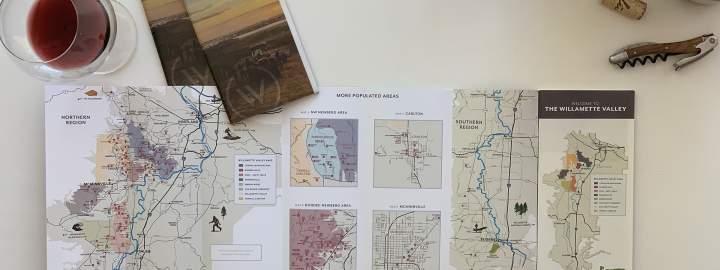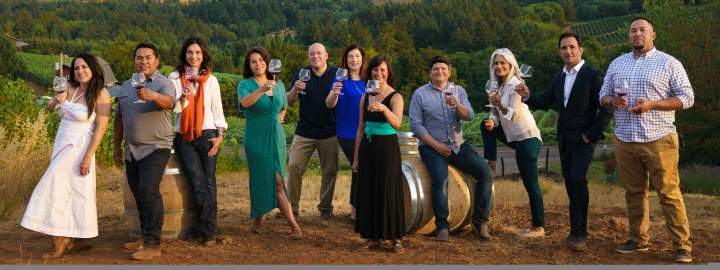Sustainable Winegrowing In Oregon
Oregon has long been a leader in environmental stewardship. The home of the nation’s most protective land use policies, the first bottle recycling law, and the highest minimum wages for farm workers, is also home to a wine industry committed to sustainable farming and winemaking practices.
At latest count in 2016, there are 13,170 vineyard acres (about 48% of Oregon’s planted vineyard acreage) certified sustainably farmed by one of several independent third party certifying organizations. Many more acres are becoming certified, in a process that takes two to three years to complete. Many Oregon wineries are now taking the next step, pursuing certification of sustainable practices in their winemaking processes and facilities. See all wineries that have a sustainability certification.
Shared Principles
There are interesting differences among approaches to sustainable farming and winemaking practices embodied in the three major certification programs commonly found in Oregon vineyards: LIVE, Organic, and Biodynamic. But it is perhaps even more interesting to discover how much they are alike in their fundamental approach to farming and winemaking, how they all share a few basic principles:
- Consider the farm and winery as a whole system and take responsibility for the health and long term viability of the whole
- Encourage biodiversity and protect wildlife habitat on the farm
- Promote soil stability, health and fertility
- Respect natural processes, reducing or eliminating use of synthetic inputs in the vineyard and the winery
- Conserve natural resources, including water and energy, in both vineyard and winery
- Protect the health and well being of workers in the vineyard and the winery, and the larger community
Independent Third Party Certification
Independent third-party certification guarantees adherence to highest standards, helps to maintain our connection with world-wide networks of research and experience in sustainability, and gives us measurable criteria to evaluate our progress.
LIVE (Low Input Viticulture and Enology) Certified. (www.livecertified.org) LIVE is a certification program developed in 1997 by an independently incorporated organization of Oregon winegrowers to provide vineyards and wineries official recognition for sustainable agricultural practices. LIVE is certified internationally by the International Organization for Biological Control (IOBC), which sets an international standard for sustainable farming practices. LIVE certification is a three-year process. A point system for ecological options requires growers to demonstrate continual improvement in diversification of the agro-ecosystem, and reductions in the use of fuels and chemical inputs such as pesticides and fertilizers. Regular third party inspections are required to maintain certification. In 2008 LIVE launched a new program for certification of winemaking processes and facilities, using a point system similar to the vineyard certification program.

Salmon-Safe (www.salmonsafe.org) is a corollary certification that certifies farming practices that restore and protect healthy streams and rivers, focusing especially on control of soil erosion and runoff, and on maintaining buffer zones in riparian areas to protect water quality. LIVE and Salmon-Safe are a dual certification, so all LIVE vineyards are Salmon-Safe.

USDA Certified Organic. Organic food production is based on a system of farming that mimics natural ecosystems and maintains and replenishes the fertility of the soil. Organic foods are produced without the use of synthetic chemical pesticides and fertilizers. Organic foods are minimally processed to maintain the integrity of the food without artificial preservatives or irradiation. Organic foods are not genetically engineered. Organic certification requires on-site inspections, legally binding contracts, detailed record keeping and periodic testing of soil, water, and produce to ensure that growers and processors are meeting the standards of the USDA National Organic Program.
Oregon certifying programs for USDA Organic include Oregon Tilth and the Oregon Department of Agriculture.

Demeter Certified Biodynamic. The Demeter Association certifies farms and products to international Biodynamic standards that date back to 1928. In order for a farm to be certified it must demonstrate that it has undergone Biodynamic stewardship for a minimum of two years, as defined by the certification guidelines. Certification must be renewed yearly. In general, Demeter certification is in accord with many practices that characterize the certification of organic farms. However, certain practices are unique to Biodynamic agriculture, including managing the whole farm as a living organism; maintenance of a healthy, diverse ecosystem that includes not only the earth, but as well the cosmic influences and rhythms of which the earth is a part; and use of the Biodynamic preparations to build soil health through enlivened compost. Learn more.

Certified B Corporation. B Lab began in 2006 with the idea that a different kind of economy was not only possible, but necessary — and that business could lead the way towards a new, stakeholder-driven model. B Lab became known for certifying B Corporations, which are companies that meet high standards of social and environmental performance, accountability, and transparency.
But we do much more than that. We’re building the B Corp movement to change our economic system — and to do so, we must change the rules of the game. B Lab creates standards, policies, tools, and programs that shift the behavior, culture, and structural underpinnings of capitalism. We mobilize the B Corp community towards collective action to address society’s most critical challenges.
By harnessing the power of business, B Lab positively impacts companies around the world, helping them balance profit with purpose. Together, we are shifting our global economy from a system that profits few to one that benefits all: advancing a new model that moves from concentrating wealth and power to ensuring equity, from extraction to generation, and from prioritizing individualism to embracing interdependence.
We won’t stop until all business is a force for good. Learn more.

LEED Certified. LEED certified buildings save money, improve efficiency, lower carbon emissions and create healthier places for people. They are a critical part of addressing climate change and meeting ESG goals, enhancing resilience, and supporting more equitable communities.
To achieve LEED certification, a project earns points by adhering to prerequisites and credits that address carbon, energy, water, waste, transportation, materials, health and indoor environmental quality. Projects go through a verification and review process by GBCI and are awarded points that correspond to a level of LEED certification: Certified (40-49 points), Silver (50-59 points), Gold (60-79 points) and Platinum (80+ points). Learn more.

Food Alliance Certified. Food Alliance works at the juncture of science, business and values to define and promote sustainability in agriculture and the food industry, and to ensure safe and fair working conditions, humane treatment of animals, and careful stewardship of ecosystems. Learn more.

The Story of Oregon Wine Sustainability
When Oregon’s pioneering winegrowers envisioned planting grapes and making wine in the state’s fertile Willamette Valley, they had a vision that went beyond making world class Pinot noir. They saw something few others did. They saw one of the last great places on earth where the land had not been spoiled by chemicals and pesticides and other harmful agricultural practices.
They saw a modern day Garden of Eden where agriculture in general and viticulture in particular could flourish in harmony with the land and the people who lived there. As one of the last unspoiled places on earth, Oregon represented not just an ideal place for winegrowing. It represented a final frontier where winegrowers could practice their trade in a biologically diverse and ecologically balanced environment.
And, they made a promise to themselves and future generations: They would produce the highest quality wine possible, but they would do it in complete synergy with nature and place their responsibility as good stewards of the land they were given above all else.
Oregonians have a long, rich and pacesetting legacy of preserving the state’s pristine ecology. It’s not uncommon for Oregon’s environmental innovations to be preceded by “first in the nation” superlatives.
Much like the state where they chose to build a new industry a half century ago, Oregon’s wine pioneers not only came to Oregon to embrace this rich environmental heritage, but have played a major role in preserving and extending it with their own innovations and forward thinking practices.
Though it has grown into a substantial industry, Oregon winemaking has much more often been a true labor of love for those who have chosen to brave hardships to go where others insisted they couldn’t. And, they’ve done it with the kind of continual care and thoughtfulness rarely seen in the for-profit business world.
Oregon established its commitment to sustainable farming practices more than 100 years ago when the state legislature enacted the state’s first environmental law, prohibiting pollution of waters used for domestic or livestock purposes. In 1967 Gov. Tom McCall signed the Beach Bill, calling it “one of the most far reaching measures of its kind enacted by any legislative body in the nation.” The bill granted the public recreational rights to the dry sands of Oregon’s beaches all the way to the vegetation line. In 1971, Oregon passed the nation’s first Bottle Bill, requiring deposits on soft drink containers.
Signed into law in May 1973, Oregon Senate Bill 100 created an institutional structure for statewide land use planning. It required cities and counties to adopt comprehensive land-use plans and placed restrictions on the urban sprawl into farmland. Many of today’s prime vineyards are located on hillsides not originally considered prime farmland. The wine industry played a major role in preserving these properties for the future development of some of today’s grand cru vineyards and kept them from being zoned for residential housing and commercial development.
The commitment of early Oregon wine growers and producers is not coincidental to the overall environmental movement in the state happening at the same time. Oregon attracted people who wanted to live in a place that reflected their values as stewards of the land.
Oregon wine producers are driven by their desire to have their wine reflect a sense of place. This inherently requires that they be able to grow their grapes naturally – which is the key ingredient in making great wine that expresses the place it’s from. Winemaking in Oregon so often is about capturing the essence of the beauty and elegance of the state in a glass of wine.
Today, Oregon boasts the greatest commitment to sustainable farming of any wine region in the U.S. More than half of Oregon’s vineyards are farmed in a sustainable manner as certified by one of several independent organizations.
Oregon’s wine industry inherited a relatively intact ecosystem when it began in the 1960s and has worked hard to maintain this high level of pristineness. Members of the industry were instrumental in the creating the Low Input Viticulture and Enology (LIVE) certification. Today, LIVE is the leader in certifying not only vineyards, but wineries as well.
Oregon’s commitment to sustainable winegrowing is also a key factor in decisions on where to invest research funds. Many of those decisions have either led directly to alternative farming practices or have led to innovation in vineyard management techniques.
In addition, the industry has a continual focus on developing sustainability standards and practices in wine production, such as reducing the weight of wine packaging, reducing energy and water use, adopting new forms of alternative energy and building winemaking and storage facilities that meet and exceed carbon neutral standards.






